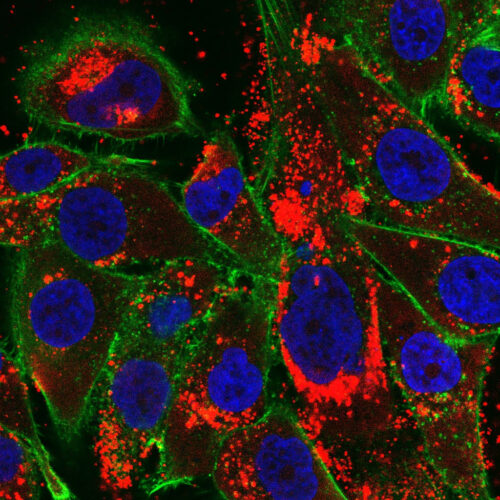Image Courtesy of Yazhe Wang.
It’s a diagnosis that strikes fear in the hearts of patients and their loved ones: glioblastoma, a type of brain cancer that is notoriously aggressive and difficult to treat. However, hope may be on the horizon, as researchers from Yale and the University of Connecticut (UConn) have developed a groundbreaking new therapeutic approach for those battling this devastating disease. The treatment loads tiny particles called nanoparticles, developed by Professor Mark Saltzman’s lab at Yale, with proteins that target the tumor cells, designed by Professor Raman Bahal and his team at UConn. Currently, the best treatment for glioblastoma is the removal of the bulk of the tumor during surgery, followed by radiation and chemotherapy. However, the median survival is only fifteen months. This new treatment combines two cutting-edge technologies, nanoparticles and peptide nucleic acids, to tackle this lethal disease and provide hope for future patients.
Nanoparticles are particles that can infiltrate cells due to their small size. Saltzman’s lab has extensively researched nanoparticles as a vehicle to deliver drugs to specific areas of the human body. The polymer-based nanoparticle developed by his team can penetrate the brain and reach the tumor cells. Saltzman underlined the importance of the nanoparticles remaining at the tumor site and continuing to deliver the drug over time. “You can only administer the therapy after surgery directly into the brain and you cannot re-administer, but we want the therapy to last a long time,” Saltzman said. “We designed nanoparticles with certain properties to allow for this behavior.” The particles have an affinity for tumor cells due to their bioadhesive coating, and they will stick around to slowly release the drug inside the cells.
The drugs encapsulated in the nanoparticles were designed by Bahal, who was a postdoctoral researcher and collaborator of Saltzman’s at Yale before moving to UConn. Bahal’s team developed peptide nucleic acids, or PNAs, to be loaded inside the nanoparticles. These proteins are synthetically constructed to be complementary to a certain sequence of microRNA, or short strands of RNA that regulate gene expression in cells. The tumor cells of glioblastomas overexpress certain microRNAs, leading to more tumor growth and decreased patient survival. Past studies suggest that two of these upregulated microRNAs, miR-10b and miR-21, are the most significant in glioblastomas. These microRNAs have been shown to exacerbate tumor growth and invasion, while decreasing the effectiveness of Temozolomide, the type of chemotherapy typically used for glioblastomas. The researchers loaded a mixture of the PNAs against miR-10b and miR-21 into the nanoparticles.
After surgery, this treatment can be administered directly into the brain to target the remaining cancerous cells. Therefore, this treatment would be an addition to the current standard of care. During mouse trials, this therapy improved survival and also enhanced the efficacy of the chemotherapy. “The results are very promising, and I think there is an opportunity here,” Saltzman said. He described how the researchers are striving to move towards more extensive safety testing and eventually clinical trials.
Glioblastomas account for just a fraction of cancer patients. In 2022, brain and other nervous system cancers added up to 1.3 percent of cancer cases in the United States, and 14.5 percent of these nervous system tumors were glioblastomas. Despite this seemingly low percentage, Saltzman has researched drug delivery systems for glioblastomas for around thirty-five years and defends its importance as a focus of research. “It’s rare, but not as rare as you would think,” Saltzman said. Even though his results were published in early February in Science Advances, he still receives one or two emails a day from people searching for new treatments for a family member suffering from a glioblastoma. Saltzman’s driving force for his glioblastoma research and this project is the hope it provides for patients. “I’ve become fascinated with this challenge and want to do something that really helps people,” Saltzman said. “Along the way, I have met a lot of individuals with glioblastoma. They are not alive anymore and that has had a huge impact on me. It feels more like a mission now than just an interesting project to work on.”
Saltzman’s nanoparticles loaded with PNAs present a novel and precise approach to address the currently inadequate landscape of therapeutic options for glioblastoma. When integrated into the standard of care, this dynamic duo has the potential to improve survival rates, finally giving glioblastoma patients a fighting chance.

